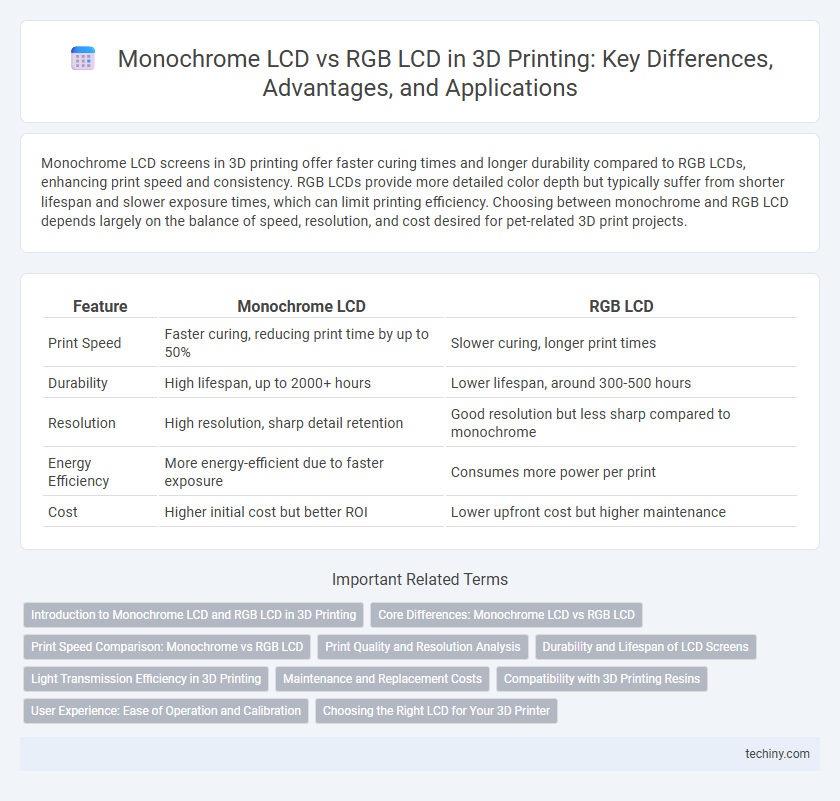Monochrome LCD screens in 3D printing offer faster curing times and longer durability compared to RGB LCDs, enhancing print speed and consistency. RGB LCDs provide more detailed color depth but typically suffer from shorter lifespan and slower exposure times, which can limit printing efficiency. Choosing between monochrome and RGB LCD depends largely on the balance of speed, resolution, and cost desired for pet-related 3D print projects.
Table of Comparison
| Feature | Monochrome LCD | RGB LCD |
|---|---|---|
| Print Speed | Faster curing, reducing print time by up to 50% | Slower curing, longer print times |
| Durability | High lifespan, up to 2000+ hours | Lower lifespan, around 300-500 hours |
| Resolution | High resolution, sharp detail retention | Good resolution but less sharp compared to monochrome |
| Energy Efficiency | More energy-efficient due to faster exposure | Consumes more power per print |
| Cost | Higher initial cost but better ROI | Lower upfront cost but higher maintenance |
Introduction to Monochrome LCD and RGB LCD in 3D Printing
Monochrome LCDs in 3D printing offer higher light transmission and faster curing times, enhancing print speed and precision for resin-based printers. RGB LCDs provide color filtering capabilities, enabling detailed color displays but often result in slower exposure times compared to monochrome screens. The choice between monochrome and RGB LCDs directly impacts print quality, speed, and overall efficiency in resin 3D printing processes.
Core Differences: Monochrome LCD vs RGB LCD
Monochrome LCD screens in 3D printing offer faster curing times and higher resolution by using a single wavelength light source, improving print speed and detail precision. RGB LCDs utilize red, green, and blue pixels to produce full-color displays but suffer from slower curing speeds and reduced light intensity due to color filters. Monochrome technology's enhanced light transmission results in longer screen durability and more efficient energy use compared to the lower lifespan and greater power consumption of RGB LCDs.
Print Speed Comparison: Monochrome vs RGB LCD
Monochrome LCDs significantly enhance print speed in 3D printing by allowing more light to pass through, reducing layer curing times compared to RGB LCDs which have color filters that slow down the process. Typically, monochrome LCDs can cure layers in 1-2 seconds, whereas RGB LCDs often require 5-8 seconds per layer due to lower light efficiency. This improvement in exposure time directly contributes to faster overall print times and higher productivity in resin-based 3D printers.
Print Quality and Resolution Analysis
Monochrome LCD screens in 3D printing offer higher resolution and sharper print quality compared to RGB LCDs due to their increased light transmittance and faster curing speeds, resulting in finer detail and smoother surfaces. The higher pixel density of monochrome displays enables more precise layer definition, reducing print times and minimizing layer-lines visible on prints. In contrast, RGB LCDs tend to suffer from reduced light efficiency, leading to slower curing and less detailed prints, which impacts overall surface finish and dimensional accuracy.
Durability and Lifespan of LCD Screens
Monochrome LCD screens in 3D printers typically offer greater durability and a longer lifespan compared to RGB LCD screens due to their simpler backlighting system that reduces heat generation and wear. The lack of color filters in monochrome displays allows higher light transmittance, decreasing the exposure time for the LCD and thereby extending its operational life. In contrast, RGB LCDs, while providing color capability, tend to degrade faster under continuous use, making monochrome LCDs the preferred choice for longevity-focused 3D printing applications.
Light Transmission Efficiency in 3D Printing
Monochrome LCDs offer significantly higher light transmission efficiency compared to RGB LCDs, enabling faster curing times and improved print quality in 3D printing. Monochrome panels typically transmit over 40% more light, which reduces exposure durations and enhances resin polymerization precision. This efficiency advantage results in longer printer lifespan and better energy utilization during the stereolithography (SLA) or masked SLA (MSLA) processes.
Maintenance and Replacement Costs
Monochrome LCDs in 3D printers offer longer lifespans and lower maintenance due to fewer color filters that degrade over time, reducing replacement frequency. RGB LCDs require more frequent replacements as their multiple color layers are prone to faster wear and pixel failures, increasing overall costs. Choosing monochrome LCDs minimizes downtime and long-term expenses associated with screen upkeep in resin 3D printing.
Compatibility with 3D Printing Resins
Monochrome LCD screens offer higher compatibility with 3D printing resins due to their increased light transmission and faster curing times, ensuring precise layer solidification. RGB LCDs typically filter specific wavelengths, which can reduce resin curing efficiency and increase print times. Choosing a monochrome LCD enhances resin activation, leading to better print accuracy and overall improved 3D printing performance.
User Experience: Ease of Operation and Calibration
Monochrome LCDs in 3D printing offer improved user experience through faster layer curing times and higher precision, reducing the need for frequent calibrations. RGB LCDs, while capable of displaying colors, often suffer from slower exposure speeds and more complex calibration processes, impacting ease of operation. The streamlined calibration and consistent performance of Monochrome LCDs make them preferable for users seeking efficiency and reliability in 3D printing processes.
Choosing the Right LCD for Your 3D Printer
Monochrome LCD screens in 3D printers offer faster curing times and longer lifespan compared to traditional RGB LCDs, enhancing print speed and durability. Their higher light transmittance improves precision and resolution, making them ideal for detailed resin printing. RGB LCDs, though more affordable, typically have slower exposure times and reduced screen longevity, which may affect overall print quality and maintenance frequency.
Monochrome LCD vs RGB LCD Infographic

 techiny.com
techiny.com